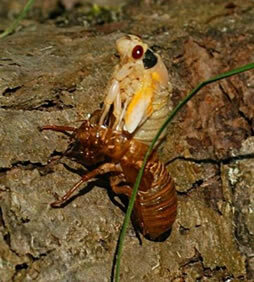You arthropods they form an extremely diverse group, with more than a million species described and cataloged around the world. These animals can be found in all regions of the planet.
The animals belonging to the phylum Arthropod they are invertebrates, triblastic and coelom. They have bilateral symmetry, exoskeleton, segmented body (metameria) and articulated appendages, which justifies the name of the phylum (arthro = articulation; prunes = paws). The fact that these animals have metameria leads to the assumption that arthropods are evolutionarily related to annelids. This metameria is clearer only in larval forms.
O exoskeleton of all arthropods is composed of chitin, but in crustaceans, in addition to chitin, there is also phosphate and calcium carbonate, substances that provide high resistance to the shell of these animals. Terrestrial arthropods are coated with a waterproof wax coating that prevents dehydration.

The arthropod undergoes moulting periodically so that its body increases in size
As the exoskeleton of arthropods involves the entire body, the growth of these animals only occurs through what we call the changes or ecdysis, which is the exchange of the exoskeleton. Moulting occurs periodically throughout the animal's development, which is always controlled by a hormone called ecdysone or molting hormone. During molting, the epidermal cells responsible for the production of the exoskeleton secrete a new skeleton under the old skeleton, and at one point the old skeleton cracks, releasing the arthropod with its new skeleton. Because it is very flexible, the new exoskeleton stretches as the animal's body expands, right after molting. After a few minutes or hours, the arthropod's new exoskeleton stiffens and the animal stops growing.
Arthropods have a complete digestive system, with extracellular digestion and an open or lacunar circulatory system, the blood being called hemolymph.
Arthropods can be classified into five classes, they are:
Insecta Class
900,000 species of insects are known, and the class Insecta is the most diverse in the phylum. Insects are the only invertebrate animals capable of flight. This ability guarantees them to reach food with ease, in addition to giving them great defensive and dispersal power. Insects are of great importance in the food chain (since many birds, amphibians, reptiles, mammals and fish feed on them), but they can also cause a lot of harm to man.
The body of insects is divided into head, thorax and abdomen. They have a pair of antennae, three pairs of legs and wings may be absent. Respiration of these animals is tracheal and excretion is done through Malpighian tubules. The nervous system of insects is ganglionic with a ventral nerve cord. Insects are dioecious animals (separate sexes), with internal fertilization and direct or indirect development. Examples: bees, grasshoppers, flies, mosquitoes, butterflies, ants, etc.
Crustacean Class
Animals of the Crustacea class are found mainly in fresh or salt water aquatic environments, with few species can be found on dry land (some are: armadillos, armadillos, armadillos and beach armadillos and beach cockroaches). Some crustaceans serve as food for fish and other larger animals. They also have a hard and resistant carapace composed of chitin and calcareous substances.
With the body divided into cephalothorax and abdomen, crustaceans have two pairs of antennae and variable number of legs (in in some species the first pair of legs can be turned into quela, a strong pincer that the animal uses to defend itself or capture foods). These animals breathe through the gills and the excretion takes place through green glands, also called antennal. Most crustaceans are monoecious and their development can be direct, but most often it is indirect. Examples: shrimp, crabs, crabs, lobsters, barnacles, etc.
Arachnid Class
Found in terrestrial environments, arachnids can be seen in woods, swamps, deserts and in homes. Some species of arachnids, such as spiders and scorpions, are venomous and their bite can cause serious accidents to humans and domestic animals. The mite is also an arachnid and can be easily found in dust, which is why it is most responsible for causing respiratory allergies. Furthermore, the mite is also responsible for causing scabies. Ticks are arachnids that also transmit diseases, such as tick disease, which affects domestic animals.
Arachnids have their bodies divided into cephalothorax and abdomen, and in ticks these parts are fused. They also have four pairs of legs, absent antennae and breathing is tracheal or phylotracheal. In addition, they have a specialized digestive tube for sucking; and in spiders and scorpions, digestion is extracorporeal. Excretion in arachnids is via the thigh glands and Malpighian tubules. Most species are dioecious with internal fertilization. Examples: spiders, scorpions, mites.
Chilopoda class
The Chilopoda class is represented by centipedes and centipedes, animals that have a body formed by a head and trunk. In the trunk of these animals there are about 170 metamers, and in each metamer there are a pair of legs. Chilopods respiration is tracheal and excretion is via Malpighian tubules. Chilopods are dioecious animals, with internal fertilization and direct development. Examples: centipedes, centipedes.
Diploped Class
The body of diplopods is formed by the head, thorax and abdomen, but some authors consider that the body of these animals is formed only by the head and trunk. The abdomen of these animals is long and, as in chilopods it is also formed by metamers, in each metamer there are two pairs of legs. They have a pair of antennae on the head, tracheal respiration and excretion made by Malpighian tubules. The diplopods are dioecious, with internal fertilization and direct development. Examples: snake lice.
by Paula Louredo
Graduated in Biology
Source: Brazil School - https://brasilescola.uol.com.br/biologia/caracteristicas-gerais-dos-artropodes.htm
